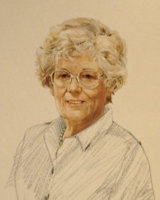A few weeks ago I was researching other sites which mention Dorothy and I came across a reference in the Electric Scotland site which is run by the now Canadian domiciled Alastair McIntyre, who had previously been the owner of Almac in Grangemouth – the first ISP that we used at James Thin when I first set up their website. The reference was contained in an article by Iain Johnstone about his book Viking Place Names of East Lothian
http://www.electricscotland.com/books/viking_names.htm
In the article he is very complimentary about Dorothy’s research for King Hereafter and her assertion that Macbeth and Thorfinn were the same man. This was in the context of discussing his outspoken view that many of the accepted derivations for Scottish Lowland place names are erroneous, and based on a faulty view of Anglo-Saxon influence on the area. He believes that many of the names are Norse in origin but have been written out of history for political reasons. I found his ideas fascinating and followed the links back to his own sites which are quite local to me at
http://www.scotsplacenames.com/ and
http://www.tarmagan.com/
The former takes a fair bit of reading and you may find his style a touch on the strident side on occasions, but it is clearly the result of his enthusiasm to tell what he believes to be the real story and the content is pretty convincing if you know much about Scots and have pored over maps and wondered at the variations in language that they reveal.
Having digested his site I wrote him an email, expressing interest and thanking him for his King Hereafter comments, and suggesting that he might like to write an article either for the website or for Whispering Gallery, or perhaps give a talk to a Dunnett event.
Sadly I was too late. His wife Margaret wrote to me this week telling me that he had died in August after a sudden illness and saying he would have been delighted to have had such contact with Dunnett readers. Both of them have been great admirers of Dorothy’s work from the time of the early Lymonds and Margaret had even read the Dollys in their original editions. I am making arrangements with her to purchase copies of both Iain’s books and will read them with interest (and probably quite a few maps!) His death came before he could update his website with the latest book but the first one can be ordered through the Tarmagan site using PayPal, and hopefully the new one will soon follow suit. Once I have a chance to read them I’ll post a review here. Now if I can just find time to re-read King Hereafter and see if there are any interesting placenames…

Thank you for this fascinating post. I have no difficulty with the idea that many place names in Scotland might have Norse origins or that substantial numbers of people might have spoken Norse at some time in the past. Does it have to be mutually exclusive, do you think? Or is it possible that some of the place names might be of mixed origin? For example, where there are Norse and Old English cognates with similar spellings, such as stein and stan, or ton and tun, is it possible that a place might have been named first in one language and then reinforced or modified by the other? Is it possible to tell these apart with the records that survive?